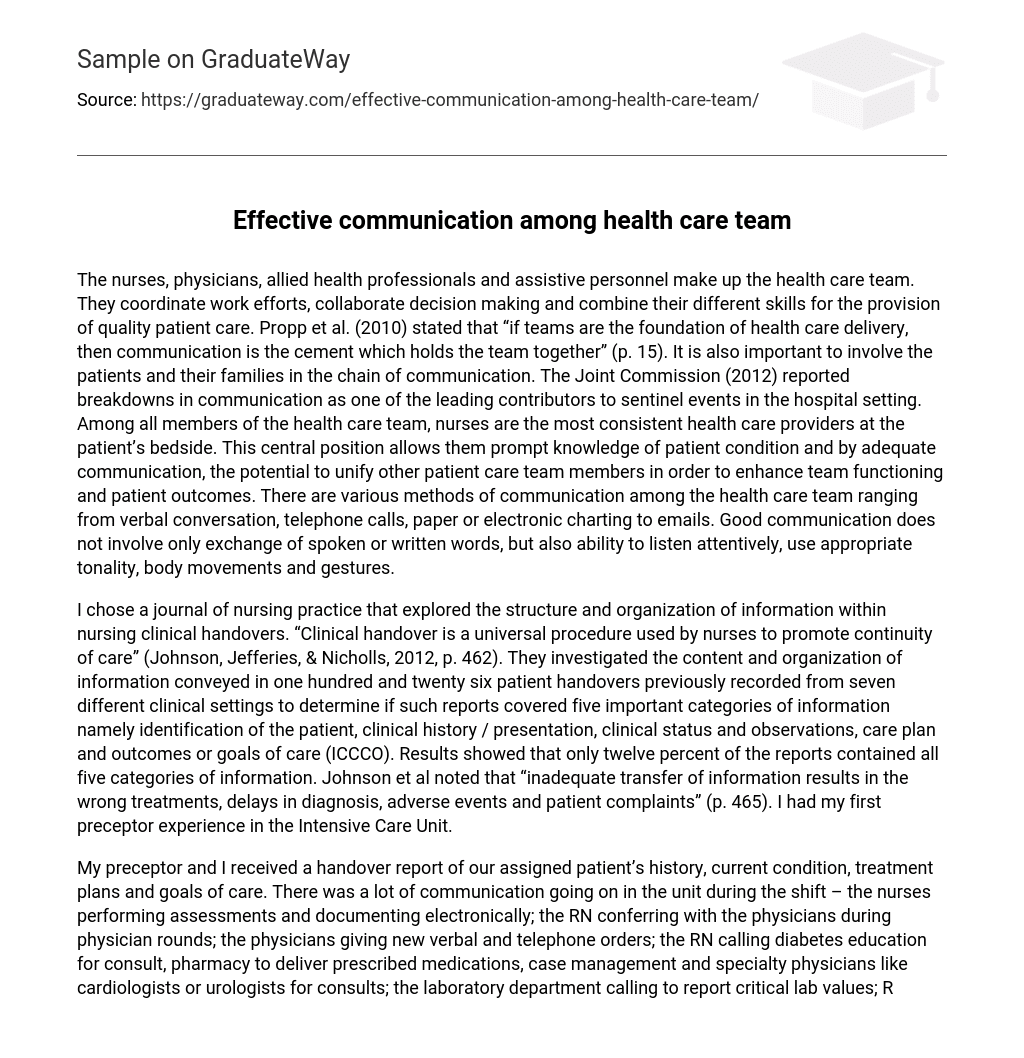The nurses, physicians, allied health professionals and assistive personnel make up the health care team. They coordinate work efforts, collaborate decision making and combine their different skills for the provision of quality patient care. Propp et al. (2010) stated that “if teams are the foundation of health care delivery, then communication is the cement which holds the team together” (p. 15). It is also important to involve the patients and their families in the chain of communication. The Joint Commission (2012) reported breakdowns in communication as one of the leading contributors to sentinel events in the hospital setting. Among all members of the health care team, nurses are the most consistent health care providers at the patient’s bedside. This central position allows them prompt knowledge of patient condition and by adequate communication, the potential to unify other patient care team members in order to enhance team functioning and patient outcomes. There are various methods of communication among the health care team ranging from verbal conversation, telephone calls, paper or electronic charting to emails. Good communication does not involve only exchange of spoken or written words, but also ability to listen attentively, use appropriate tonality, body movements and gestures.
I chose a journal of nursing practice that explored the structure and organization of information within nursing clinical handovers. “Clinical handover is a universal procedure used by nurses to promote continuity of care” (Johnson, Jefferies, & Nicholls, 2012, p. 462). They investigated the content and organization of information conveyed in one hundred and twenty six patient handovers previously recorded from seven different clinical settings to determine if such reports covered five important categories of information namely identification of the patient, clinical history / presentation, clinical status and observations, care plan and outcomes or goals of care (ICCCO). Results showed that only twelve percent of the reports contained all five categories of information. Johnson et al noted that “inadequate transfer of information results in the wrong treatments, delays in diagnosis, adverse events and patient complaints” (p. 465). I had my first preceptor experience in the Intensive Care Unit.
My preceptor and I received a handover report of our assigned patient’s history, current condition, treatment plans and goals of care. There was a lot of communication going on in the unit during the shift – the nurses performing assessments and documenting electronically; the RN conferring with the physicians during physician rounds; the physicians giving new verbal and telephone orders; the RN calling diabetes education for consult, pharmacy to deliver prescribed medications, case management and specialty physicians like cardiologists or urologists for consults; the laboratory department calling to report critical lab values; RNs explaining patient conditions to family members and providing answers to their questions; asking for assistance or delegating tasks to assistive personnel and handing off reports to other RNs during lunch breaks and at the end of shift. My patient was sedated, so there was not a lot of communication between us but I was given an opportunity to talk to a family member over the phone to update her of the sister’s current condition and the plan of care for the day. The interdependence of the health care team in providing effective patient care was very evident through the shift.
Blevins, S. (2012) wrote that “having effective communication as well as involving the patient and family provides continuity of care and prevents error. Communication can make a scary situation more manageable so time can be spent on what really counts – the patient” (p. 212).
References
Blevins, S. (2012). The Power of Communication. MEDSURG Nursing, 22(4), 212-213. Johnson. M., Jefferies, D., & Nicholls, D. (2012). Exploring the structure and organization of information within nursing clinical handovers. International Journal of Nursing Practice, 18, 462-470. Propp, M. K., Apker, J., Zabava, W. S., Wallace, N., Serbenski, M., and Hofmeister, N. (2010). Meeting the Complex Needs of the Health Care Team: Identification of Nurse-Team Communication Practices Perceived to Enhance Patient Outcomes. Qualitative Health Research, 20(1), 15-28. The Joint Commission. (2012). Sentinel event data: Root causes by event type 2004-2012 Powerpoint Slides. Retrieved from





